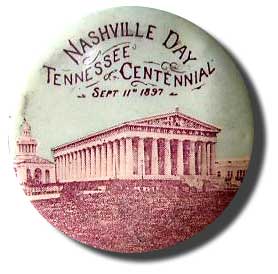Nashville and wonder
Yesterday, upon my return from Nashville, I dusted off The Parthenon, (Harvard University Press, 2003) classicist Mary Beard’s neat, readable, and illuminating volume on the West’s most famous building. I wanted to catch up on the temple’s lore, after visiting Centennial Park’s full-scale replica of the Parthenon, originally built for 1897’s Centennial Exposition in what the guidebooks like to call the “Athens of the South.”

Nashville’s Parthenon houses an exhibition about the history of the building—including glimpses into the Exposition—as well as a rather pedestrian art gallery and a replica of Athena Parthenos; the most intriguing bits were the photos and descriptions of the Centennial grounds and attractions, ripe with wonder.
As with any modern fair, the Exposition was chock full of attractions, a kind of midway denoted “Vanity Fair,” with attractions ranging from the “Streets of Cairo” (featuring a replica pyramid sponsored by Nashville’s sister city of Memphis, Tennessee; a similar attraction was featured at Chicago’s 1893 fair) to the “Cuban Village,” hawking “Mexican Dancing Girls; Cuban Dancing Girls; Spanish Dancing Girls” (photos from the 1939 World’s Fair, set in New York, show another such recreation). Other photographs show the outside of the café of Night and Morning, a live-action dramatization of Dante’s Inferno, featuring skeletons with illuminated red eyes, tables made from coffins, and chandeliers fabricated from human skulls and bones (a similar journey through heaven and hell was featured at Coney Island in 1907, according to research recorded on a UCLA website); a “cyclorama” of the battle of Gettysburg, the interior 360° mural painted over sixteen months by artists; and rides, including a giant see-saw and the chute, a car that plunged 200 feet to a shallow pool of water.
And that’s just the beginning: Algiers is reimagined in the guise of a “Moorish Palace,” with turbaned and fezzed guards ushering the visitors into a wax museum of “exotic and macabre” objects; fifteen cents purchased an admission to Thomas Edison’s “Mirage,” a theater of four life-sized motion picture images, projected via the inventor’s kinetoscope; and recreated “sham battles” offered a close-up view of the Custer’s demise at Little Bighorn.
There isn’t a hell of a lot on the web about the Exposition, so I ordered a used copy of Tenessee Centennial: Nashville 1897 (Arcadia, 1998) in their “Images of America” series: I’ve never sorted the documentation on the numerous world’s fairs of the era, but the simple fact that attractions seem to show up in different cities merits further research. Wonderous stuff.
See also: The climactic scene in Robert Altman’s Nashville—reviewed in these pages about a month ago—takes place in Centennial Park on the Parthenon’s stairs.



































0 Comments:
Post a Comment
<< Home